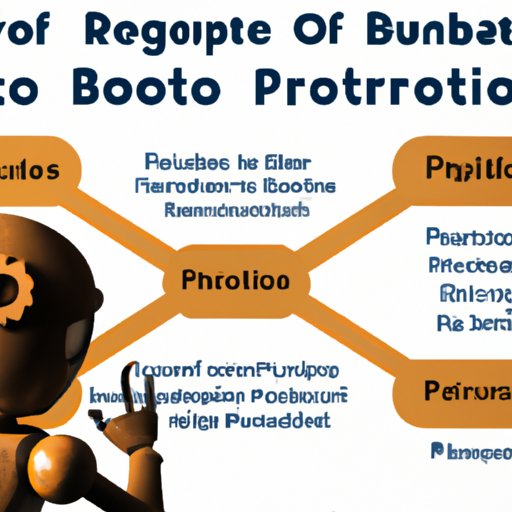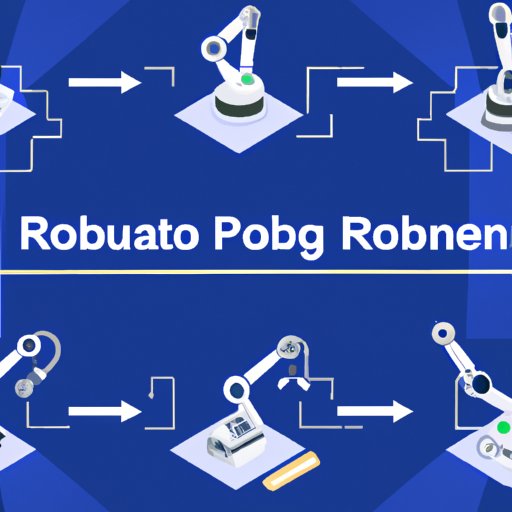Introduction
Robotic process automation (RPA) is a form of business automation technology that enables companies to automate repetitive tasks and processes. The goal of RPA is to reduce costs, improve efficiency and accuracy, and streamline operations. This article will explore how robotic process automation works, including the steps required for implementation, the potential benefits and challenges, and real-world examples of RPA in action.
A Step-by-Step Guide to Robotic Process Automation (RPA)
In order to understand how robotic process automation works, it is important to first understand the basics of RPA. RPA is a type of business automation technology that uses software robots, or “bots”, to automate repetitive tasks and processes. These bots are programmed to perform specific tasks and can be integrated into existing systems and processes, eliminating the need for manual labor. By automating tasks, businesses are able to reduce costs, increase efficiency and accuracy, and streamline operations.
Once a business has identified opportunities for RPA implementation, it needs to consider the steps required for implementation. First, the business must decide on an RPA solution that best meets its needs. Next, the business must plan and design the RPA process, which includes identifying the tasks that can be automated and mapping out the workflow. Finally, employees must be trained on the RPA technology so that they can effectively use and manage the system.

Exploring the Benefits and Challenges of Robotic Process Automation
Robotic process automation offers several benefits to businesses, including cost savings, improved accuracy, and increased efficiency. According to a study by McKinsey, the average organization can reduce operating costs by up to 40% when implementing RPA. Additionally, RPA can improve accuracy by eliminating human error, as well as reduce processing times and increase productivity.
However, there are also potential challenges associated with RPA. For example, businesses need to ensure that they have the right infrastructure in place to support RPA technology, as well as invest in training employees on the technology. Additionally, businesses must also consider security risks associated with RPA, such as data breaches and malicious attacks.
How Businesses Can Implement Robotic Process Automation
Implementing robotic process automation in a business requires careful planning and consideration. First, businesses must decide on an RPA solution that best meets their needs. There are a variety of RPA solutions available, from cloud-based solutions to on-premise solutions. Each solution offers different features and capabilities, so it is important to research and compare the various options to determine which one is right for the business.
Next, businesses must plan and design the RPA process. This involves identifying the tasks that can be automated, mapping out the workflow, and developing the necessary processes and procedures. Once the RPA process has been designed, businesses must then train employees on the technology so that they can effectively use and manage the system.

An Overview of Robotic Process Automation Technology
Robotic process automation technology is rapidly evolving, with new tools and solutions being developed every day. There are three main types of RPA solutions available: cloud-based solutions, on-premise solutions, and hybrid solutions. Cloud-based solutions are hosted in the cloud and offer scalability and flexibility, while on-premise solutions are installed directly on a company’s servers. Hybrid solutions combine the benefits of both cloud-based and on-premise solutions.
The benefits of RPA technology include cost savings, improved accuracy, increased efficiency, and streamlined operations. Additionally, RPA technology can be integrated into existing systems and processes, eliminating the need for manual labor. As RPA technology continues to evolve, more businesses are beginning to recognize the potential benefits of implementing RPA in their organizations.
Real-World Examples of Robotic Process Automation in Action
To better understand how robotic process automation works, let’s take a look at some real-world examples of RPA in action. One example is automating data entry. By using RPA, businesses can automate the process of entering data into databases, eliminating the need for manual data entry. This can help reduce costs and improve accuracy, as well as save time.
Another example is automating invoicing. By using RPA, businesses can automate the process of creating and sending invoices, reducing the amount of time and effort required to complete this task. Additionally, RPA can also be used to automate customer service tasks, such as responding to customer inquiries or resolving customer issues.
Conclusion
Robotic process automation is a powerful business automation technology that can help businesses reduce costs, improve accuracy, and increase efficiency. In order to successfully implement RPA, businesses must first decide on an RPA solution, plan and design the RPA process, and train employees on the technology. Additionally, businesses must consider the potential benefits and challenges of RPA before implementation.
Real-world examples of RPA in action include automating data entry, invoicing, and customer service tasks. As more businesses begin to recognize the potential benefits of RPA, the technology is becoming increasingly popular among organizations of all sizes. As RPA technology continues to evolve, it is likely to become an even more integral part of business operations in the future.
(Note: Is this article not meeting your expectations? Do you have knowledge or insights to share? Unlock new opportunities and expand your reach by joining our authors team. Click Registration to join us and share your expertise with our readers.)
